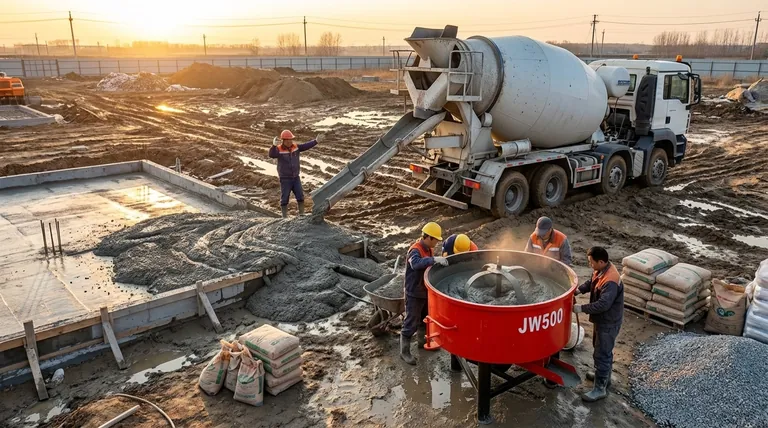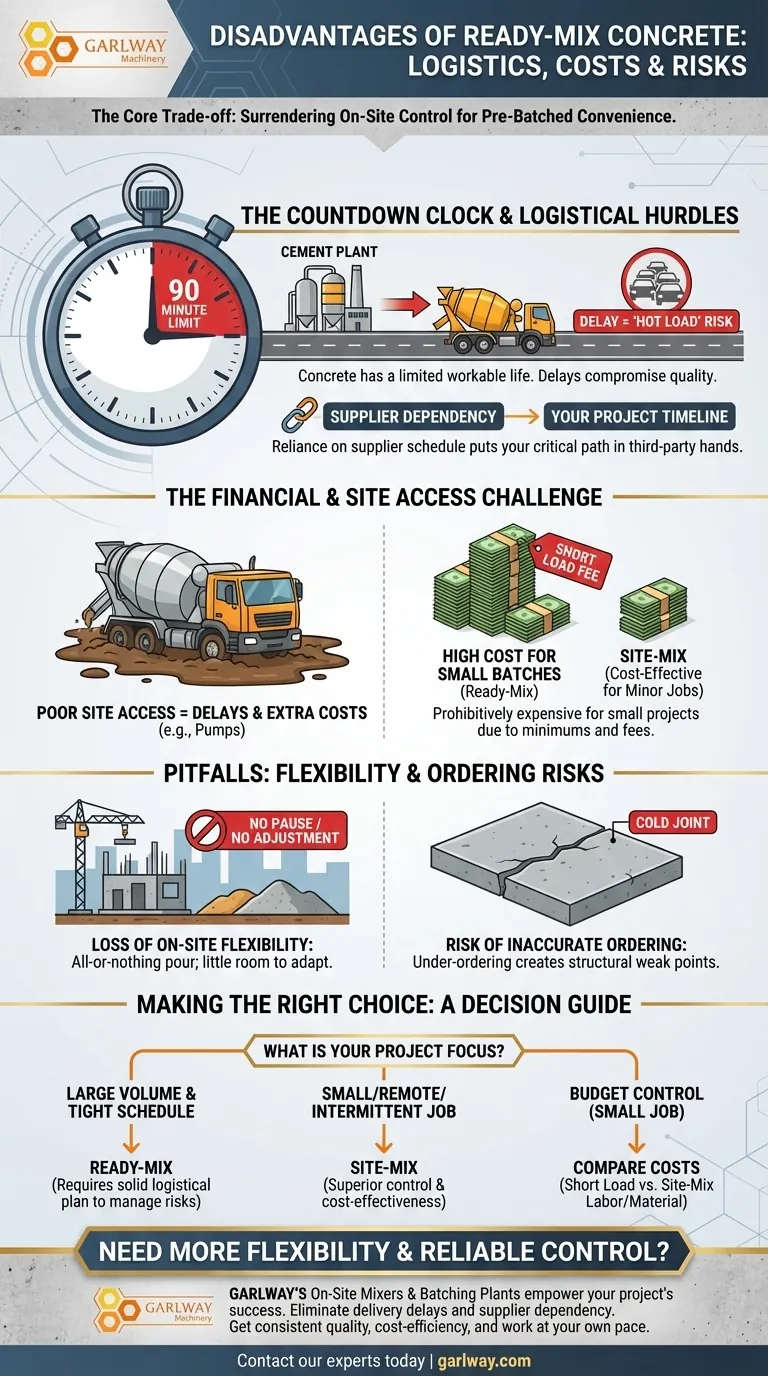While convenient and consistent, ready-mix concrete is not without significant drawbacks. The primary disadvantages revolve around its time-sensitive nature, the high dependency on the supplier's schedule and quality control, and potential cost inefficiencies for smaller projects. These factors introduce logistical risks that must be carefully managed.
The core trade-off of ready-mix concrete is surrendering on-site control for the convenience of a pre-batched product. Its primary disadvantages are not in the material itself, but in the complex logistics of getting a perishable product from the plant to your forms on a strict timeline.

The Core Challenge: Time and Logistics
The moment water is added to a cement mix, a chemical reaction called hydration begins. This starts a countdown clock that dictates the entire ready-mix process, creating several logistical hurdles.
The Countdown Clock: Limited Travel Time
Concrete has a limited workable life, typically around 90 minutes from batching. Any delay in transit, whether from traffic, plant scheduling, or site issues, can compromise the concrete's quality.
A delayed truck can result in a "hot load," where the concrete has begun to set, making it difficult to pour, place, and finish properly. This directly impacts the final strength and durability of the structure.
The Chain of Dependency: Reliance on the Supplier
When you order ready-mix, you are entirely dependent on the supplier's schedule, batching accuracy, and delivery fleet. You have no direct control over the process until the truck arrives.
This dependency means a plant running behind schedule can throw your entire project's timeline into disarray. You are placing the critical path of your project in the hands of a third party.
The Final Hurdle: Site Access
Ready-mix trucks are incredibly heavy and require stable, clear access to the pour site. Poor ground conditions, like mud or soft soil, can prevent the truck from getting into position, causing major delays or even cancellation.
This lack of access can force the use of expensive concrete pumps or labor-intensive wheelbarrows, adding unexpected costs and complexity to the pour.
Understanding the Financial and Environmental Costs
Beyond the immediate logistical concerns, ready-mix carries other important considerations related to its cost structure and environmental impact.
Cost Inefficiency for Small Batches
Ready-mix plants are optimized for large-volume production. For small projects, such as a patio or sidewalk repair, ready-mix is often prohibitively expensive.
Most suppliers enforce a minimum order quantity or charge a significant "short load" fee for any amount below several cubic yards. This can make site-mixing a far more economical option for minor jobs.
The Environmental Footprint
The production of Portland cement, the key ingredient in concrete, is a major source of global CO2 emissions. Furthermore, the transportation of heavy, wet concrete from a central plant to multiple job sites consumes a significant amount of fossil fuel.
While this applies to all concrete, the centralized nature and long-haul delivery model of ready-mix contribute substantially to this environmental impact.
Common Pitfalls and Trade-offs
Choosing ready-mix means accepting a specific set of risks in exchange for convenience. Understanding these trade-offs is crucial for project success.
Loss of On-Site Flexibility
With site-mixed concrete, you can mix batches as needed, pause work, and make small adjustments to the mix. Ready-mix delivery is an all-or-nothing event.
Once the truck arrives, the pour must happen immediately. There is very little room to adapt to unforeseen on-site issues without risking the entire load of concrete.
The Risk of Inaccurate Ordering
Accurately estimating the required volume of concrete is critical. Over-ordering results in wasted material and disposal costs, while under-ordering is a far more serious problem.
Running short may require placing a second, expensive short-load order and can create a "cold joint"—a weak point between the two separate pours that compromises structural integrity.
Making the Right Choice for Your Project
The decision to use ready-mix concrete should be based on a clear understanding of your project's scale, location, and timeline.
- If your primary focus is a large-volume pour with a tight schedule: The consistency and speed of ready-mix are invaluable, but you must have a solid logistical plan to manage delivery and site access risks.
- If your primary focus is a small repair, a remote location, or requires intermittent work: The disadvantages of ready-mix are significant, and the control and cost-effectiveness of site-mixing often make it the superior choice.
- If your primary focus is budget control on a small job: Always compare the cost of a ready-mix short load against the material and labor costs of mixing it yourself.
By weighing these disadvantages against the benefits, you can make an informed decision that ensures your project's success.
Summary Table:
| Disadvantage | Key Impact |
|---|---|
| Time-Sensitive Delivery | Concrete can set in transit, risking a 'hot load' and compromising strength. |
| Supplier Dependency | Project timeline is reliant on the plant's schedule and batching accuracy. |
| Site Access Issues | Requires stable ground; poor access can lead to delays and extra costs for pumping. |
| High Cost for Small Batches | Short-load fees make it expensive for small projects like patios or repairs. |
| Loss of On-Site Flexibility | Pour must happen immediately upon delivery, with no room for pauses or adjustments. |
Need a more flexible and reliable concrete solution for your project?
At GARLWAY, we understand the logistical challenges of construction. Our range of high-performance concrete mixers and batching plants gives you complete on-site control, eliminating the risks of delivery delays and supplier dependency. Whether you're a contractor working on a large-scale development or a smaller, intermittent job, our machinery ensures consistent quality, cost-efficiency, and the flexibility to work at your own pace.
Let GARLWAY's construction machinery empower your project's success. Contact our experts today to find the perfect concrete solution for your needs!
Visual Guide

Related Products
- Portable Concrete Mixer Machine Equipment for Mixing Concrete
- HZS35 Small Cement Concrete Mixing Batch Plant
- HZS75 Concrete Batching Plant Cement Mixer Price Concrete Mixer Bunnings Mixing Plant
- HZS180 Ready Mix Concrete Plant for Foundations with Sand and Cement
- Commercial Construction Mixer Machine for Soil Cement Mixing Concrete
People Also Ask
- What are the disadvantages of concrete mixers? Hidden Costs & Quality Risks Revealed
- What are the factors influencing choice of a concrete mixing plant? Key Considerations for Efficiency
- What is the use of a portable concrete mixer? Maximize On-Site Control & Efficiency
- What are the components of concrete mixing? Master the Ingredients and Machinery for Perfect Results
- How much concrete can you mix in a portable mixer? Maximize Efficiency on Small Jobs



















